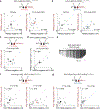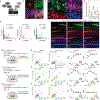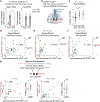Bidirectional perisomatic inhibitory plasticity of a Fos neuronal network
- PMID: 33299180
- PMCID: PMC7864877
- DOI: 10.1038/s41586-020-3031-0
Bidirectional perisomatic inhibitory plasticity of a Fos neuronal network
Abstract
Behavioural experiences activate the FOS transcription factor in sparse populations of neurons that are critical for encoding and recalling specific events1-3. However, there is limited understanding of the mechanisms by which experience drives circuit reorganization to establish a network of Fos-activated cells. It is also not known whether FOS is required in this process beyond serving as a marker of recent neural activity and, if so, which of its many gene targets underlie circuit reorganization. Here we demonstrate that when mice engage in spatial exploration of novel environments, perisomatic inhibition of Fos-activated hippocampal CA1 pyramidal neurons by parvalbumin-expressing interneurons is enhanced, whereas perisomatic inhibition by cholecystokinin-expressing interneurons is weakened. This bidirectional modulation of inhibition is abolished when the function of the FOS transcription factor complex is disrupted. Single-cell RNA-sequencing, ribosome-associated mRNA profiling and chromatin analyses, combined with electrophysiology, reveal that FOS activates the transcription of Scg2, a gene that encodes multiple distinct neuropeptides, to coordinate these changes in inhibition. As parvalbumin- and cholecystokinin-expressing interneurons mediate distinct features of pyramidal cell activity4-6, the SCG2-dependent reorganization of inhibitory synaptic input might be predicted to affect network function in vivo. Consistent with this prediction, hippocampal gamma rhythms and pyramidal cell coupling to theta phase are significantly altered in the absence of Scg2. These findings reveal an instructive role for FOS and SCG2 in establishing a network of Fos-activated neurons via the rewiring of local inhibition to form a selectively modulated state. The opposing plasticity mechanisms acting on distinct inhibitory pathways may support the consolidation of memories over time.
Conflict of interest statement
Figures
















References
-
- Greenberg ME & Ziff EB Stimulation of 3T3 cells induces transcription of the c-fos proto-oncogene. Nature 311, 433–438 (1984). - PubMed
Publication types
MeSH terms
Substances
Grants and funding
LinkOut - more resources
Full Text Sources
Other Literature Sources
Molecular Biology Databases
Research Materials
Miscellaneous

